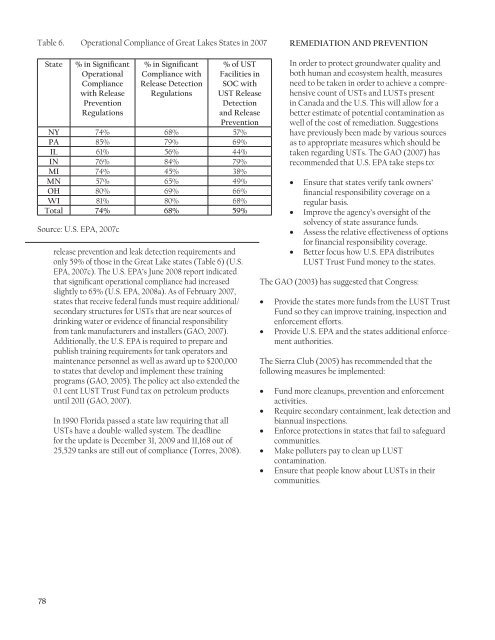Groundwater in the Great Lakes Basin
Groundwater in the Great Lakes Basin
Groundwater in the Great Lakes Basin
Create successful ePaper yourself
Turn your PDF publications into a flip-book with our unique Google optimized e-Paper software.
Table 6. Operational Compliance of <strong>Great</strong> <strong>Lakes</strong> States <strong>in</strong> 2007<br />
REMEDIATION AND PREVENTION<br />
State<br />
% <strong>in</strong> Significant<br />
Operational<br />
Compliance<br />
with Release<br />
Prevention<br />
Regulations<br />
% <strong>in</strong> Significant<br />
Compliance with<br />
Release Detection<br />
Regulations<br />
% of UST<br />
Facilities <strong>in</strong><br />
SOC with<br />
UST Release<br />
Detection<br />
and Release<br />
Prevention<br />
NY 74% 68% 57%<br />
PA 85% 79% 69%<br />
IL 61% 56% 44%<br />
IN 76% 84% 79%<br />
MI 74% 45% 38%<br />
MN 57% 65% 49%<br />
OH 80% 69% 66%<br />
WI 81% 80% 68%<br />
Total 74% 68% 59%<br />
Source: U.S. EPA, 2007c<br />
release prevention and leak detection requirements and<br />
only 59% of those <strong>in</strong> <strong>the</strong> <strong>Great</strong> Lake states (Table 6) (U.S.<br />
EPA, 2007c). The U.S. EPA’s June 2008 report <strong>in</strong>dicated<br />
that significant operational compliance had <strong>in</strong>creased<br />
slightly to 65% (U.S. EPA, 2008a). As of February 2007,<br />
states that receive federal funds must require additional/<br />
secondary structures for USTs that are near sources of<br />
dr<strong>in</strong>k<strong>in</strong>g water or evidence of f<strong>in</strong>ancial responsibility<br />
from tank manufacturers and <strong>in</strong>stallers (GAO, 2007).<br />
Additionally, <strong>the</strong> U.S. EPA is required to prepare and<br />
publish tra<strong>in</strong><strong>in</strong>g requirements for tank operators and<br />
ma<strong>in</strong>tenance personnel as well as award up to $200,000<br />
to states that develop and implement <strong>the</strong>se tra<strong>in</strong><strong>in</strong>g<br />
programs (GAO, 2005). The policy act also extended <strong>the</strong><br />
0.1 cent LUST Trust Fund tax on petroleum products<br />
until 2011 (GAO, 2007).<br />
In 1990 Florida passed a state law requir<strong>in</strong>g that all<br />
USTs have a double-walled system. The deadl<strong>in</strong>e<br />
for <strong>the</strong> update is December 31, 2009 and 11,168 out of<br />
25,529 tanks are still out of compliance (Torres, 2008).<br />
In order to protect groundwater quality and<br />
both human and ecosystem health, measures<br />
need to be taken <strong>in</strong> order to achieve a comprehensive<br />
count of USTs and LUSTs present<br />
<strong>in</strong> Canada and <strong>the</strong> U.S. This will allow for a<br />
better estimate of potential contam<strong>in</strong>ation as<br />
well of <strong>the</strong> cost of remediation. Suggestions<br />
have previously been made by various sources<br />
as to appropriate measures which should be<br />
taken regard<strong>in</strong>g USTs. The GAO (2007) has<br />
recommended that U.S. EPA take steps to:<br />
• Ensure that states verify tank owners’<br />
f<strong>in</strong>ancial responsibility coverage on a<br />
regular basis.<br />
• Improve <strong>the</strong> agency’s oversight of <strong>the</strong><br />
solvency of state assurance funds.<br />
• Assess <strong>the</strong> relative effectiveness of options<br />
for f<strong>in</strong>ancial responsibility coverage.<br />
• Better focus how U.S. EPA distributes<br />
LUST Trust Fund money to <strong>the</strong> states.<br />
The GAO (2003) has suggested that Congress:<br />
• Provide <strong>the</strong> states more funds from <strong>the</strong> LUST Trust<br />
Fund so <strong>the</strong>y can improve tra<strong>in</strong><strong>in</strong>g, <strong>in</strong>spection and<br />
enforcement efforts.<br />
• Provide U.S. EPA and <strong>the</strong> states additional enforcement<br />
authorities.<br />
The Sierra Club (2005) has recommended that <strong>the</strong><br />
follow<strong>in</strong>g measures be implemented:<br />
• Fund more cleanups, prevention and enforcement<br />
activities.<br />
• Require secondary conta<strong>in</strong>ment, leak detection and<br />
biannual <strong>in</strong>spections.<br />
• Enforce protections <strong>in</strong> states that fail to safeguard<br />
communities.<br />
• Make polluters pay to clean up LUST<br />
contam<strong>in</strong>ation.<br />
• Ensure that people know about LUSTs <strong>in</strong> <strong>the</strong>ir<br />
communities.<br />
78

















